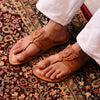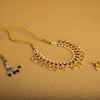Kolhapuri Chappals- A GI tagged Handmade Product

Kolhapuri Chappals Specification:
-
Kolhapuri Chappals are renowned for aesthetically pleasing look and known for decorative woven pattern fixed over upper bands of these Chappals.
-
Kolhapuri Chappal are handmade open Indian footwear made of tanned vegetable leather produced using traditional technique and tools.
-
In Kolhapuri Chappal all parts of chappal – sole, uppers and heel are from bag tanned vegetable tanned leather. Stitching of outer sole, insole and upper and heel with leather thread taken from bag tanned leather.
-
The Kolhapuri chappals are produced by chamers of Maharashtra and Karnataka from Geographical area of production.
Kolhapuri Chappals Description:
- The Kolhapuri chappals is a traditional craft practiced by chamers of Maharashtra and Karnataka, which are renowned for their aesthetically pleasing look of open Indian footwear and recognized for its decorative woven pattern.
- Kolhapuri Chappal are handmade footwear made of vegetable tanned leather produced using traditional technique and tools.
- In Kolhapuri Chappal all parts of chappal – sole, uppers and heel are from bag tanned vegetable tanned leather. Stitching of outer sole, insole and upper and heel with leather thread taken from bag tanned leather.
- Bag tanned leather, using babulbark and myrobalan fruits.
- Degree of tannage of bag tanned leather around 40%.
- It exhibit shape memory on wetting/soaking in water.
- Stitching of outer sole, insole and upper and heel with leather thread taken from bag tanned leather is followed in most of the Kolhapuri Chappals, however, in recent times, in some places pasting is also followed.
- Decorative woven pattern fixed over upper bands are from Head skin or goat skin tanned by bag tanners in the same bag tanning pit.
Geographical area of Production and Map:
- The geographical area of Production of Kolhapuri Chappal covers parts Maharashtra and Karnataka.
- The Area of production of Kolhapuri Chappal in Maharashtra comprises of Sholapur, Sangli, Kolhapur and Satara districts.
- The Area of production of Kolhapuri Chappal in Karnataka comprises of Dharwad, Belgaum, Bagalkot and Bijapur districts
Proof of Origin (Historical records):
The origin of Kolhapuri Chappal can be traced back to 12th Century rule of King Bijjal of Bidar district and his Prime Minister Viswaguru Basavanna (Basaveswara) who wanted to create a casteless society and remove stigma associated with Chamar community. As such Basaveswara sought an appointment for lunch with a chamar by name Haralayya. Traditionally Haralayya
and his family involved in footwear manufacturing. Basaveswara was greatly impressed by his visit to Haralayya’s House. As a token of appreciation and love for Basaveswara, Haralayya made a pair of footwear using vegetable tanned skin and a part of his own skin from his thigh and as well as his wife Kalyanamm’s thighs and presented to Basaveswara. The Viswaguru Shri
Basaveswara didn’t wear the chappal, but kept it on his head, saying it is a Divine Footwear, as it was partly made from their own skin of Haralayyas. He returned the footwear to Haralayya. While taking back the footwear, a Brahmin Assistant in the Aasthan, by name Madhuvarsh grabbed it from Haralayya and wore the footwear. As soon as he worn it, he developed paralysis and became bed ridden. Hearing the incidence, the Jagadguru Shri Basaveswara advised Madhuvarsh to seek the pardon of Haralayya and also bathe in the liquid he used to make the footwear. He refused to do so. Then Lavanyavathi, daughter of Madhuvarsh went to Haralayya’s house and sought his pardon and came back home with a pot of liquid used in footwear manufacture and gave it to her father. After bathing with that processing liquid, he fully recovered from his ailment. Then he realized the greatness and divinity of Haralayya and as a gesture of gratitude, he offered his daughter in marriage to Sheelavanth, Harlayya’s son.
Thus Basaveswara achieved his objective of creating casteless society and in turn the chamer turned to lingayat faith and began worshipping lingu.
Further, the chamars considered that 12th century period as a glorious chapter in their lives to dedicate their lives to lingyat faith and consider work as worship. It is with that spirit, the chamer community made excellent varieties of footwear and used their creative work in footwear production. Hence, the 12th century was the beginning of footwear made by the Chamars using bag tanned leather and it looked like Kolhapuri. However, the name Kolhapuri
that was prefixed to it was only form the beginning of 20th Century.
There is also some recorded information on the status of tanning, probably bag tanning in Kolhapur, Chatrapati Shahu (1874‐1922) was responsible to shift tanning units from Bindu Chowk to Yallomareal, in the outskirts of the town. About 29 tanning centrtes were in vogue during this period (1895).
In the undivided Bombay State (before 1947), most of the Kolhapuri chappals were produced form bag tanned leathers by chamars of Maharashtra and Karnataka in the select districts referred under Geographical area of production. The name of Kolhapuri has come into existence as chappals made and traded in Kolhapur, enable others in other districts of undivided Bombay State to make similar type of chappals from bag tanned Leather. Hence, the name Kolhapuri was used and is being used by all the chamars irrespective of the place from where they are produced in Bombay State. After the reorganization of States, after Independence, some of the districts have formed part of Karnataka and the tanners and chamars continue to follow the same methods of production in their respective places.
Method of Production:
The Kolhapuri chappal is completely and exclusively made from bag tanned vegetable leather.Hence, for Kolhapuri chappal, bag tanned leather is the pre‐requisite.The methods of production therefore shall include two stages –
(I) Manufacture of bag tanned leather and
(II) Manufacture of Kolhapuri chappal.
(I) Manufacture of Bag Tanned Leather:
The traditional/orthodox process as adopted by Artisans in the geographical areas where bag tanned (vegetable) leather and chappals, are produced is described below:
1. Raw materials:
- Buffalo hides – Green/wet salted/ weighing about 25‐30 kg. each. Cow hides, calf skins of buff and cow are also used.
- Lime (slaked)
- Vegetable tanning material: Babulbark (Acacia Arabica) and myrobalan nuts (Terminalia Chebula).
- Miscellaneous: Sisal fibre for stitching into bags and hand tools for unhairing fleshing, beaming and scrubbing.
2. Soaking:
- The raw hides, if they are of green hides, wash the hides thoroughly in 2‐3 changes of water to clean the surfaces from dirt and blood.
- If the raw material is of wet salted type, soak the hides for 1 day in water, handling once or twice.
- After the soaking is completed, indicated by softness and rehydration, take out, drain the water.
3. Liming:
- Put the hides in old lime liquor, in a rectangular 4’x6’x5’ pit and handle it by hauling up once a day and keep the hide in the same pit for 6 days.
- On the 7th day, the old lime liquor is strengthened by adding about 10 Ibs. of slaked lime per hide. The hides are put in this lime liquor for about 10 days, each day handling and hauling up once.
- Now the hides become plump and swollen. The stock is taken out, unhaired with unhairing knife and then fleshed with a fleshing knife, washed with water, scudded to remove short hair and to clean the surface. Wash thoroughly in 2 – 3 changes of water. Now cut the hides into sides by cutting along the spinal line.
4. Deliming:
- The sides are put in water, trampled well to remove lime from the sides. After leaving overnight in water, the sides get delimed upto 2/3 of its thickness. The stock is now ready for vegetable tanning.
5. Vegetable Tanning:
- It involves two stages – colouring and suspension. The colouring bath consists of weak babul liquor, made from bark of branches crushed myrobalan and soaking in water.
- The sides are put in this liquor for two days. Take out, wrung and put in second colouring bath for another two days. The skins now get coloured on both grain and flesh side, leaving central portion still untanned.
- After this, the sides are taken out, wrung, water is drained by keeping on bamboo poles,then stitched into a bag, using strong sisal fibre, leaving opening on the neck portion.
- The bag is filled up with a mixture of babul bark and crushed myrobalan nuts (10 : 7) upto 1/3rd of its height and then suspended over wooden logs, into a pit (rectangular) measuring about 7’x5’x2’.
- Water and tan liquor are poured into the bag through the opening in the neck portion. Tanning takes placed by penetration of tan liquor by osmotic pressure into the interior spacs in the skin.
- The liquor collected into the pit is put back into the bag each time when sufficient quantity is collected. The bags are kept in this condition for two days, after which a knot is tied at 2/3rd of its height.
- The bag is taken out. The mouth is opened on the butt portion and the mouth on the neck portion is closed. Thus, reversing the bag direction, the bag is suspended over the pit. Tan Liquor is poured into the bag at frequent intervals for two days.
- By this time, the middle portion of the bag also gets tanned. At this stage, the knot is removed, the bark and myrob are allowed to slip into the butt portion, the balance 1/3 portion of the bag and the bag is kept in this position for two days, by which time, the entire side gets tanned.
- Thus, the entire side is tamed in 3 steps. After this process, the bag is taken out, cut open to make the side flat and placed on a bamboo pole, beamed, scrubbed and washed with water thoroughly.
- The sides are dried in the sun on the flesh side for one day. When the sides are still damp, they are put back into the tanning pit for 1 or 2 days. Then taken out and dried in order to make them ready for selling.
- The whole production from raw to tanning takes about 30‐32 days. The yield varies from 40‐45% on raw weight.
6. Other variations in Methods and Production:
- The above method is the most widely used process followed by the tanners, producing leather for Kolhapuri chappals. However, some bag tanners are straightaway putting the soaked hides in fresh lime liquor, instead of old time liquor, keeping a total liming period of 15 days.
- Bag tanning was also practiced extensively in Punjab (Jalandhar), West Bengal (Kolkatta) and U.P. (Kanpur) in the past. However, the process differed in use of certain natural materials such as SajjiMatti in kiming, limed fleshings.
(II) Manufacture of Kolhapuri Chappal:
1. Raw Material:
Bag tanned vegetable buff leather. Bag tanned cow/bag tanned buff calf or cow calf are also used.
These are handed over from generation to generation. At times, the producer makes his own pattern by taking actual foot measurements and then grading by increasing 1/3 inch in length for each size. These patterns are cut in rubber sheets.
3. Grading:The patterns are availablefor grades 6 to 11 for gents and grades 5‐9 for ladies.
4. Making Upper and bottom stock:
-
Mostly bag tanned vegetable buff leather is used for soles as well as for uppers. At times, bag tanned cow leather soles are also made use of. Buff calf/cow calf leathers (bag tanned) are also used for making uppers.
-
The bag tanned leather is wetted to ease cutting. Cut into outer sole and insole, using pattern sheets. The cut soles are exposed to sun drying While in damp condition, the leather is hammered heavily and repeatedly to make the leather even, flat and pressed.The soles are then polished by rubbing with a porcelain cup/rod.
-
In the case of punched designs, the desired designs are punched with punchers on the grain side of the insole as well as on upper straps.
-
In case no punches are made, earthern soil is applied in between bottom sole and insole to keep them together temporarily.
-
Meanwhile, too ring and instep band are prepared with leather taken from belly portion and fixed over it a plaited/woven/decorative leather piece.
-
Also a toe loop/strap (woven in leather) is attached passing forward from Instep band to a point adjacent to toe ring on the sole between toe to anchor forepart of the foot. At times, there can be two such toes loops Now, the Instep band is enclosed between outer sole and insole and the toe loop into a slot near the toe. The heel piece is also fixed. The whole chappal is now stitched with a leather rope, taken from tail portion of the same bag tanned leather. The sole stitching is all around the sole and also in the middle of the sole.
-
In the case of Kapshe (Kapsi), the insole is rubbed with a mixture of coconut and ground nut oil to get shining and glossiness. In some special types of Kapshe, 3 sole pieces are attached together and stitched. Such chappals are soft and shiny and last longer.
-
In some areas of production, now‐a‐days, stuck process is followed, instead of stitching method practiced for several decades. In the stuck on process, all operations and their sequence is the same as in all other places, but only latex is used to paste the soles and upper bands to the sole. Upper bands are also riveted in the side of a lever, ear piece (Leather) inserted between outer and insoles.
-
In some types, there can be toe and and instep band.
-
In all other places, only stitching with leather thread is followed.
-
At times, the upper band and the woven straps and their lining can be vegetable tanned goat/sheep skins or head leather (vegetable tanned).
Uniqueness:
-
The Kolhapuri chappals is a traditional craft practiced by chamers of Maharashtra and Karnataka, which is renowned across India and abroad for their aesthetically pleasing look of open Indian footwear.
-
The Producers of Kolhapuri Chappal follow centuries old traditional practices and fully handmade.
-
Kolhapuri Chappal are handmade footwear made of vegetable tanned leather produced using traditional technique and tools, following Eco‐friendly processing and production.
-
Kolhapuri Chappals are known for resistance to abrasion and water absorption. They have shape memory even when wet back/soaked in water.
-
Kolhapuri Chappals are suitable for rugged use for farmers – a fashion footwear with soft and spring action in wear for urbanites and elite.
-
Kolhapuri Chappals are known for sturdy and long durability.
NOTE-
 -Geographical Indication (GI Mark), Mark of Authenticity you can rely on...!
-Geographical Indication (GI Mark), Mark of Authenticity you can rely on...!
The above information is extracted from the database of "Geographical Indications Registry, Government of India". This information is used for making the customers aware of GI Tag and Genuineness of Kolhapuri Chappals. Kalapuri does not hold any copyright of the above data or misleads the customer. Please click on the below "Orginal Document" of Government of India.
Original Document





